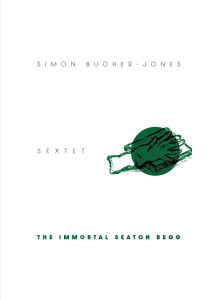Today, dear listener, it’s the Day of the Daves, as two of our brave reviewers, Dave Jeffery and Dave Brzeski, dig into books – a novel, The Resurrectionists, by Michael Patrick Hicks, and a collection of novellas, The Immortal Seaton Begg by Simon Bucher-Jones.
And in passing news of greydog-related projects, the editor stuff continues – Occult Detective Magazine #7 (Cathaven Press) is due out in the next week or so, as is the chunky two volume anthology Sherlock Holmes and the Occult Detectives (Belanger Books).
Also, the Kindle edition of Black Dogs, Black Tales, the charity anthology for mental health, is out now, including John Linwood Grant’s story ‘Grey Dog’. A good cause.
We do have a black dog, but she now has a distinctive white mask and is therefore Ghost Dog, Righter of Wrongs…

More Linwood Grant stories are in the pipeline, but mostly under wraps at the moment, so we can’t bore you with the details. And who wants to hear about him, anyway? After that, maybe enough time to write some new fiction, and more articles here… we shall see!
N.B. The greydogtales listenership is quite broad and varied, so be warned that we ourselves have not read The Resurrectionists yet, and it is apparently rather gruesome, with various unpleasantnesses in it (check out what Dave J has to say below). Maybe we’ll stick to Miss Marple for now.
The Immortal Seaton Begg
Author: Simon Bucher-Jones
Publisher: Obverse Press
Format: Paperback/Kindle
Reviewer: Dave Brzeski
The first thing I noticed on reading the first story in this book was a striking similarity to another character. Initials S.B., office in Baker Street during the Great Detective’s ‘hiatus’. Was this, I wondered, some sort of alternate universe version of Sexton Blake? My inquiries soon led me to discover that this indeed was the case, as the character originated as a pastiche of Blake in a number of stories by Michael Moorcock.
In fact, Seaton Begg gets around a bit. Not only has he featured in quite a few of Moorcock’s novels & stories, but he also appeared in a couple of Alan Moore’s Tom Strong comics. Not being all that familiar with the character myself, I decided to order a copy of The Metatemporal Detective, Moorcock’s collection of Seaton Begg stories. However, I should hopefully have finished this review by the time that arrives…
The first of four novellas in this collection is, ‘The Glove With Six Fingers’, which is set in 1895. Bucher-Jones’ talent for writing in an archaic period style is immediately evident here. He does it so accurately that It’s entirely possible that some modern readers may find it off-putting. Begg is revealed as having no belief in the supernatural, even when presented with evidence of the inexplicable. As he states, “… thing not being understood did not require it to be occult.” In this case, that of a threatened kidnapping/murder being used as possible leverage on an important man, in the attempt to acquire esoteric knowledge, Begg proves himself perfectly capable of working within the beliefs of others to catch his quarry. To some extent, the stranger aspects of this story owe more to weird science than they do to the supernatural. I found myself very intrigued by a mysterious character, who appears here with little explanation.
While I, personally, had no problem with Bucher-Jones’ use of archaic language and phraseology, I did have one small problem with the way this was written. Bucher-Jones uses a lot of footnotes full of references to characters and cases, which I find almost impossible to ignore. I constantly halted my reading of the story to do a search on a name, or a title to see if it was a genuine reference, or spurious detail. This speaks more to my obsession with crossovers and the like than an actual failing in the writing. I contacted the author to ask about the footnotes and was informed that many were disguised (for copyright reasons) references to Sexton Blake stories. Others referred to books that didn’t exist, by authors who did, as a means of better tying the stories to the historical setting. Armed with this useful information, I decided to suppress my usual habits and just read the stories. I could play with the footnotes later.
‘The Case of the Vanishing Mummy’, set in 1912, unsurprisingly involves a murder in a museum and a missing mummy. It’s another more, or less mundane mystery with certain pseudoscientific (alchemical) elements. By ‘mundane’, I refer to the lack of any supernatural factors, not that it’s in any way boring. The criminal plot is a little far-fetched, but this very fact turns out to be the method via which Begg identifies one of the miscreants responsible.
We move forward to 1935 for the third tale, ‘Sign of a Black Shadow’. This time, the fantastic elements are limited to the villain’s incredible mastership of disguise and Begg’s own seeming immortality. It seems to be a common trope in Begg’s adventures that they all feature deeply convoluted plots, but we have to remember the nature of the series it was very much based on was ever so. The daughter of a character from the first story reroutes a planned action to Begg’s home and involves him in a fascinating, if unlikely adventure, involving a secret college society and their bizarre and downright dangerous initiation pranks.
Weird science, rather than the occult is again the focus of the final story in this collection – ‘Seaton Begg vs. the Murder Machines’, set in 1979. Sexton Blake fans will immediately recognise the villain of the piece as a thinly disguised version of Zenith the Albino, one of Blake’s more memorable adversaries and the subject of no less than two novels in his own right. This is the most blatantly Blake under another name tale in the collection, but it’s also my favourite. It has the sort of inconclusive ending that is so typical of tales involving the protagonist’s major nemesis.
The collection doesn’t quite end there, as we’re presented with an epilogue, subtitled ‘Death of a Screen Icon’. Set in 2018, it’s the opening of a further adventure which will only be seen if Obverse Press decide to continue the series. We are advised to petition them to do so, albeit I suspect actual copies sold will be of more value in that respect.
It should be fairly easy for those who wish to read the Sexton Blake stories referenced under different names in the footnotes to work out which ones they represent by matching the publication dates given with the exhaustive list on Mark Hodder’s excellent Sexton Blake website. http://www.mark-hodder.com/blakiana/index.html
Crossover fans will also find much to intrigue them, with references to works by Arthur Conan Doyle, Sax Rohmer, H.P. Lovecraft, P.G. Wodehouse, August Derleth and others. Rest assured, though, one does not need to be familiar with any of these works to enjoy this book. It really makes no difference in that respect.
To pick up a copy, go to:
https://obversebooks.co.uk/product/immortal-begg/
The Resurrectionists (Salem Hawley Series: Book One)
Author: Michael Patrick Hicks
Publisher: High Fever Books
Format: Paperback/Kindle
Review: Dave Jeffery
Hicks’ The Resurrectionists is the first in a series of cosmic horror novellas (at the time of writing there are two available from High Fever Books) to feature Salem Hawley, a free Black American, who has gained emancipation in acknowledgement of his role fighting for the colonies during the American Revolution. The story, set in New York a few years after the end of British rule, centres on a group of doctors who use resurrectionists (unscrupulous thugs who dig up corpses of the recently deceased) to procure cadavers for anatomical and surgical exploratory science. However, some of the medics form part of an occultist society, bent on exacting bizarre and violent rituals, and thus evoke ancient gods from alternative dimensions. To do this, they use living specimens, usually female prostitutes snatched from the streets by people in their employ.
Hawley is brought into the tale when resurrectionists begin to target the graves of the Black Community as repercussions from the governing council are generally tepid, if not non-existent. After a graveside ruckus with the gang who are trying to remove the recently interred bodies of a friend’s family, Hawley finds himself on a collision course with the gang and their occultist employers.
The Resurrectionists has a lot going for it. In a character such as Hawley, the premise is unique, and the first half of the novella is a gripping, fascinating study of racism and hypocrisy in fledgling America. Through Hawley’s eyes we get a perspective of life as a Black American in the 1800s, and the ambiguity around what constitutes being ‘free’ at a time when liberty as a construct was new to all. There is also a huge amount of historical detail that augments the reader with the narrative, making it easy to invest in the story as it rattles along. Hicks’ writing style is assured and effective, not shying away from drawn out, graphic portrayals of sadistic ritualistic torture. In some instances, the descriptions steer into extreme horror territory, and herein lies some of the novellas problems.
The book is short, the graphic scenes of violence – detailed. In the opening scene, we have a toe-curling description of a woman being ritualistically butchered on a surgical table. The scene runs for over six pages. The last act of the novella (a heady riot at the local hospital as cosmic forces break through) takes up over 20 pages. As exhilarating as this undoubtedly is, Hicks has had to sacrifice something key to the whole premise. Namely, his central character. Hawley is a casualty in that he is having to take a back seat to the action. In truth, we know little about him as the series concludes its first episode. It is acknowledged here that this may well be the author’s intention as this is the beginning of a series. However, the mettle of a character is what keeps the reader reading, and their continued investment in a series. There was, in this reviewer’s opinion, not enough Hawley in this Salem Hawley novella.
That said, the real strength of any series is the answer to the question: Will a reader pick up a second book? The scene is certainly set for Borne Of The Deep (Salem Hawley Series Book 2). It is safe to say that there was certainly enough in this first outing to have this reviewer already downloading the second title onto the Kindle. Take from that what you will…
Recommended reading for those who enjoy their cosmic horror graphic and gory.
And you can find an interview with Michael Patrick Hicks from last year here:



